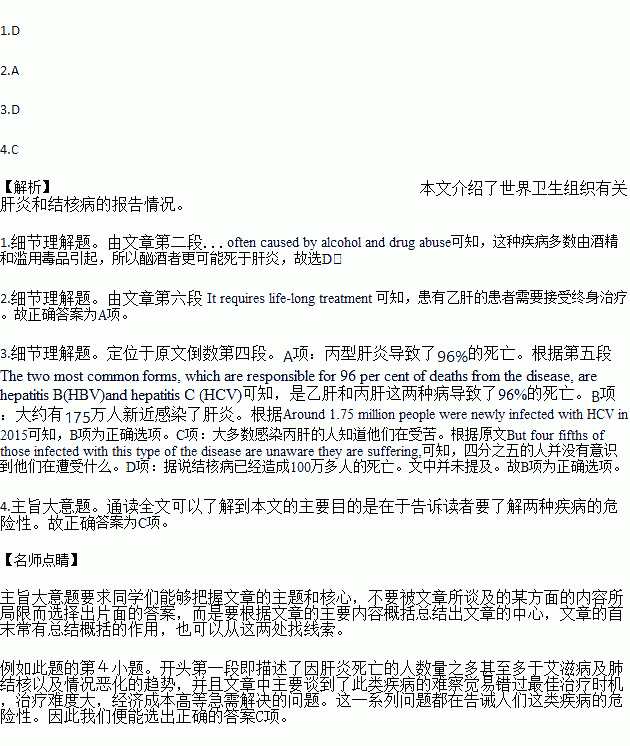题目内容
More people are dying from hepatitis(肝炎) than AIDS and tuberculosis, warns World Health Organization. The World Health Organization(WHO) has urged for action to wipe out hepatitis as ongoing illness worsens.
In its first global report on the infection, it said the number of people dying from treatable forms of the disease, often caused by alcohol and drug abuse, is rising. Viral hepatitis is believed to have killed 1.34 million people in 2015, and amount similar to that of tuberculosis.
But while those are both falling, hepatitis deaths are on the rise—increasing by 22 per cent since the turn of the century.
However, most of the 325 million people infected are completely unaware they have the virus and some lack life-saving medicines. As a result, millions of people are at risk of a slow progression to chronic liver disease, cancer and even death, the WHO warned, Margaret Chan, director general of the WHO, said: “Viral hepatitis is now a major public health challenge that requires an urgent response.”
The two most common forms, which are responsible for 96 per cent of deaths from the disease, are hepatitis B(HBV) and hepatitis C (HCV)
HBV can be passed on through unprotected sex and bodily fluids(液体). It requires life-long treatment with a drug commonly used to battle HIV. New infections of this type of the disease are falling, thanks to a vaccine given to 84 per cent of newborns across the world. However, just nine per cent of sufferers know they are infected, meaning many go under the radar and miss out on treatment.
HCV, usually spread through blood-to-blood contact with an infected person, can be cured relatively swiftly, but many patients across the world are unable to afford the medication. Around 1.75 million people were newly infected with HCV in 2015, bringing the global total to 71 million, figures suggests. But four fifths of those infected with this type of the disease are unaware they are suffering, the WHO warned.
Experts looking at the cases have identified unsafe healthcare procedure and injection drug use as the top causes. Gottfried Hirnschall, director of WHO’s Department of HIV and the Global Hepatitis Programme, said the WHO was working with governments, drugmakers and diagnostics companies to improve access.
He added: More countries are making hepatitis services available for people in need—a diagnostic test cost less than $1 (78p) and the cure for hepatitis C can be below $ 200 (£156). But the data clearly highlight the urgency with which we must address the remaining gaps in testing and treatment.
Charles Gore, president of the World Hepatitis Alliance, said: “For the first time in the history of viral hepatitis, we have an understanding of the true impact of the disease.”
1.Who are likely to die from the treatable hepatitis?
A. Those taking medicines. B. Those suffering from cancer.
C. Those caring their illnesses. D. Those being heavy drinkers.
2.What can we learn about hepatitis B?
A. Patients need to take drugs for the rest of their lives.
B. People will not get the new infections due to a vaccine.
C. Patients can be cured effectively at a costly price.
D. People will get infected through blood accidentally.
3.According to the statistics in 2015, which of the following statements is TRUE?
A. Hepatitis C is responsible for 96 per cent of deaths.
B. Around 1.75 million people were newly infected with hepatitis.
C. Most of those infected with HCV are aware they are suffering.
D. Tuberculosis is believed to have killed more than 1 million people.
4.The main purpose of writing the passage is _____.
A. to call on the public to fight with hepatitis
B. to request the public to care about the hepatitis patients
C. to warn the public to learn of the danger of the disease
D. to persuade the public to take regular examinations yearly


 ur things are neccessary. Firstly, we must understand the language when we hear 1.spoken.. Secondly, we must be able to speak it correctly with confidence and without hesitation. 2. ,we must be able to read the language , and fourthly, we must be able to write it. We must be able to make sentences that are grammatically correct.
ur things are neccessary. Firstly, we must understand the language when we hear 1.spoken.. Secondly, we must be able to speak it correctly with confidence and without hesitation. 2. ,we must be able to read the language , and fourthly, we must be able to write it. We must be able to make sentences that are grammatically correct.